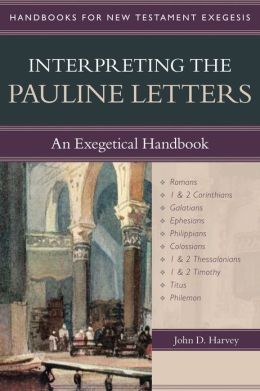“Designed as a handbook for seminary and graduate students, the book provides a go-to guide that will also serve seminary-trained pastors, upper-level college students, and well-motivated lay people. As readers work through this handbook, they will begin to see and interpret the narrative writings as Paul intended them to be understood.”

When I first read the title I immediately thought of Dr. Schreiner’s excellent work Interpreting the Pauline Epistles. Schreiner’s work is one that has been influential in shaping my reading of Paul’s letters. Therefore, I was anxious to see how Harvey’s work compared to Schreiner’s.
At present I am preaching through 1 Thessalonians and so I thought it would be beneficial to use this as a resource to see exactly how valuable it would be in preaching through a text.
As I picked up this book to begin my study of 1 Thessalonians I immediately noticed that a general index and a Scripture index is missing from the back. That would have been immediately helpful. In fact the absence of such an index makes this almost too time consuming to use as a preaching resource. I have to scan through the entire work to find things on 1 Thessalonians.
What I do find is helpful. There is a section on the major themes of each of Paul’s letters. Here I get help in placing the text in it’s historical context. (Here I think Harvey is a little more in depth than Schreiner). I notice also that there is a section on the structure of the passages. Here Harvey helps the reader layout the structure of a given passage. (I immediately note that Schreiner’s treatment tops Harvey in this section).
I really appreciate Harvey’s sixth chapter, here he gives valuable homiletical tips on interpreting and preaching/teaching through Paul’s letters. The seventh chapter is also helpful in that it gives a couple of examples of preparing and communicating a sermon from one of Paul’s epistles.
Overall, I’m not exceedingly helped in my study of 1 Thessalonians. I learn some background information but that is information I could find elsewhere. I like the help that Harvey gives on structure but I can find that in Schreiner. So what I find that I am left with, is a book that is good to read, helpful in shaping the way that I do exegesis, but ultimately not one that I will continue to consult.
A scripture index would have made this a much more valuable resource. As it stands it is a book that I will probably read through once and not consult much more. And that is sad, because there is valuable information in here. But without having a helpful index I doubt I will think to pull this book out when preparing a sermon. This is simply because I will have to almost re-read the entire book to glean a few salient points on the passage I am preaching. I can get most of this information out of a commentary.
In summary this book provides great content but is lacking in one very needful tool to make this book more accessible through all seasons.
It’s a great book for the beginning seminary student or motivated lay-person trying to learn how to better interpret passages of Scripture. For this reason it has value and I’d encourage you to purchase it. But sadly not as much value as it could have had if someone had taken the time to add 4-5 pages of an index.
Buy it here.
No comments:
Post a Comment